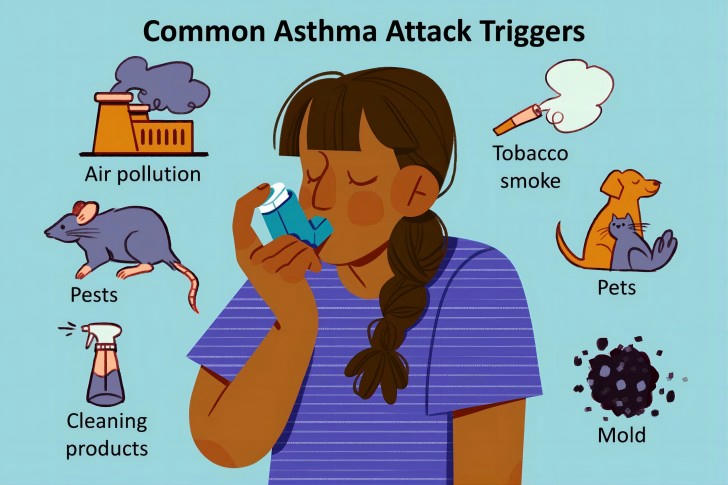Asthma: Causes and Prevention Measures
Asthma: Causes and Prevention Measures
Asthma is a chronic disease that affects the airways, primarily characterized by inflammation and constriction of the airways, making it difficult for patients to breathe. Symptoms include persistent or recurring coughing, wheezing, breathlessness,and chest tightness, especially at night, after exercise,or with seasonal changes.

What are the common triggers of asthma?
The most common triggers of asthma inclu
• Allergies
Substances that cause allergies (allergens) such as pollen, dust mites, mold, and pet dander can trigger asthma symptoms.
• Infections
Colds, flu, and other respiratory infections are a common trigger, causing about 4 out of 5 severe asthma attacks.
• Air pollution and irritants
Smoke from cigarettes, wood fires, and charcoal grills, as well as air pollution, strong fumes, and chemicals can trigger asthma.
• Exercise
Physical activity, especially in cold air, is a common asthma trigger.
• Weather
Dry wind, cold air, sudden changes in temperature, and thunderstorms can trigger asthma episodes.
• Strong emotions
Anger, fear, excitement, laughter, yelling, and crying can alter breathing and trigger asthma symptoms.
• Medications
Aspirin, ibuprofen, and beta blockers are some medicines that can trigger asthma attacks in sensitive individuals.
• Hormonal changes
Shifts in female sex hormones during the menstrual cycle or menopause can worsen asthma.
The specific triggers vary from person to person. Identifying and avoiding triggers, when possible, is an important part of managing asthma symptoms.
How can I identify my personal asthma triggers?
Identifying personal asthma triggers is crucial for effective asthma management. Triggers can vary widely among individuals, and recognizing them can significantly reduce the frequency and severity of asthma symptoms. Here are steps and methods to help identify your specific triggers

Steps to Identify Your Triggers
• Keep an Asthma Diary
Document your daily activities, environmental conditions, and any asthma symptoms you experience. Note the time and circumstances surrounding any flare-ups. This can help you identify patterns and potential triggers over time.
• Use an Asthma Home Environment Checklist
Assess your home for potential triggers. This checklist can help identify allergens and irritants present in your living space, such as dust, mold, or pet dander. The Minnesota Department of Health provides resources for this purpose.
• Consult with Healthcare Providers
Work with your doctor or an allergist to discuss your symptoms and potential triggers. They may recommend allergy testing to pinpoint specific allergens that affect you.
• Monitor Environmental Factors
Pay attention to weather conditions, pollen counts, and air quality indices. Limit outdoor activities on high pollen days or during poor air quality conditions.
By systematically assessing your environment and lifestyle, you can gain insights into your unique asthma triggers and take proactive steps to manage your condition effectively.
Case Study
• John Wilson, a decorator
John Wilson is a decorator who uses waterproof glue in his work. After working for a year and a half, he found that he had difficulty breathing after working for about ten minutes each time. After a doctor's diagnosis, it was determined that he had occupational asthma.
John Wilson's occupational asthma was mainly caused by the following factors
• Waterproof glue ingredients
Waterproof glue contains diphenylmethylene diisocyanate, which is a known allergen.
• Insufficient ventilation
The lack of adequate ventilation in the workplace results in an excessive concentration of chemicals.
• Lack of protective measures
Failure to use appropriate respiratory protective equipment at work.
How can asthma be effectively prevented?
To effectively prevent asthma, it is crucial to implement a comprehensive asthma management plan tailored to individual needs. Here are key strategies for asthma prevention

Preventive measures
Understanding personal asthma triggers is vital. Common triggers include
• Allergens
Dust mites, pollen, mold, animal dander
• Irritants
Tobacco smoke, strong odors, air pollution
• Infections
Colds and respiratory infections
• Weather Changes
Extreme temperatures or humidity
• Physical Activity
Certain exercises may trigger symptoms
Keeping a diary to track symptoms and potential triggers can help identify patterns and facilitate avoidance strategies.
Develop an Asthma Action Plan
Collaborate with a healthcare provider to create an asthma action plan. This plan should include
• Medication Management
This section provides information on prescribed medications, including reliever and preventer inhalers, along with instructions on how to use them.
• Symptom Monitoring
Guidelines for recognizing worsening symptoms and when to seek medical assistance.
• Peak Flow Monitoring
Utilizing a peak flow meter to evaluate lung function and detect early signs of an asthma episode.
Medication Adherence
Taking asthma medications as prescribed is essential for controlling symptoms and preventing attacks. This includes
• Reliever Inhalers
Used for immediate relief during an asthma episode.
• Preventer Inhalers
Regular use helps reduce inflammation and prevent symptoms from worsening.
Consult with a healthcare provider to ensure proper inhaler technique, as improper use can diminish effectiveness.
Environmental Control
Improving the home environment can significantly reduce asthma triggers.
• Air Filtration
Use HEPA filters to remove allergens and pollutants from the air.
• Humidity Control
Maintain optimal humidity levels to prevent mold growth.
• Allergen-Proofing
Implement measures such as using dust mite covers and reducing clutter to minimize allergen exposure.
Regular Health Check-ups
Routine visits to a healthcare provider for monitoring asthma control are crucial. This allows for timely adjustments to treatment plans based on symptom changes or new triggers.
Lifestyle Modifications
Incorporate healthy lifestyle practices, such as
• Regular Exercise
Engage in physical activities that are well-tolerated,such as swimming, which can be beneficial for lung health.
• Vaccinations
Stay updated on vaccinations, especially the flu shot, to prevent respiratory infections that could worsen asthma.
Education and Support
Educating yourself and those around you about asthma management is essential. Ensure that family and friends understand how to assist during an asthma episode and recognize the signs of worsening asthma.
By following these strategies, individuals with asthma can significantly reduce the frequency and severity of asthma attacks, leading to a healthier, more active life.
